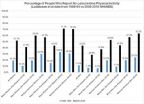(Press-News.org) GRAND RAPIDS, Mich. — A survey of first-year Grand Valley State University students showed the biggest barrier to receiving a Human Papillomavirus (HPV) vaccine was moral or religious beliefs, or a perceived promotion of sexual behavior, according to graduate physician assistant researchers.
Physician Assistant Studies majors Jamie Phillipich and Margie Webb surveyed 1,000 incoming students last fall as part of their master's research project. They assessed the influence media has on the perception of HPV and vaccine compliance, and presented their findings at the Annual American Academy of Physician Assistants CME Conference in May.
The HPV vaccines are commonly recommended for children ages 11-12 to protect against cervical cancers in women, and genital warts and other cancers in men.
Phillipich said she and Webb chose incoming first-year students in 2013 as that population was among the first to receive the vaccines when it was introduced in 2006 for girls and 2009 for boys.
Survey questions included where students received information about the vaccine, HPV knowledge, vaccination barriers and vaccination status. Results from the 146 respondents included the following:
51.4 percent reported receiving the Gardasil vaccination, and 40.3 percent received all three recommended doses.
91 percent reported moral barriers to the vaccination, higher than other barriers (lack of education, cost, lack of medical recommendation).
Nearly 70 percent reported receiving information about the vaccines from their health care provider.
65 percent reported receiving information about the vaccines from media.
Webb and Phillipich said it's important as future physician assistants to understand where their patients are receiving information to be able to give informed recommendations.
They are currently writing a manuscript for publication of their findings; both are expected to graduate in December.
INFORMATION: END
GVSU researchers find moral beliefs barrier to HPV vaccine
Graduate students surveyed 1,000 first-year students
2014-07-07
ELSE PRESS RELEASES FROM THIS DATE:
Dodging dots helps explain brain circuitry
2014-07-07
PROVIDENCE, R.I. [Brown University] — A neuroscience study provides new insight into the primal brain circuits involved in collision avoidance, and perhaps a more general model of how neurons can participate in networks to process information and act on it.
In the study, Brown University neuroscientists tracked the cell-by-cell progress of neural signals from the eyes through the brains of tadpoles as they saw and reacted to stimuli including an apparently approaching black circle. In so doing, the researchers were able to gain a novel understanding of how individual ...
Satellites reveal possible catastrophic flooding months in advance, UCI finds
2014-07-07
Irvine, Calif., July 7, 2014 – Data from NASA satellites can greatly improve predictions of how likely a river basin is to overflow months before it does, according to new findings by UC Irvine. The use of such data, which capture a much fuller picture of how water is accumulating, could result in earlier flood warnings, potentially saving lives and property.
The research was published online Sunday in the journal Nature Geoscience.
A case study of the catastrophic 2011 Missouri River floods showed that factoring into hydrologic models the total water storage information ...
Why 'whispers' among bees sometimes evolve into 'shouts'
2014-07-07
Let's say you're a bee and you've spotted a new and particularly lucrative source of nectar and pollen. What's the best way to communicate the location of this prize cache of food to the rest of your nestmates without revealing it to competitors, or "eavesdropping" spies, outside of the colony?
Many animals are thought to deter eavesdroppers by making their signals revealing the location or quality of resources less conspicuous to outsiders. In essence, they've evolved "whispers" in their signals to counter eavesdropping.
But some species of bees in Brazil do the exact ...
Obesity, large waist size risk factors for COPD
2014-07-07
Obesity, especially excessive belly fat, is a risk factor for chronic obstructive pulmonary disease (COPD), according to an article in CMAJ (Canadian Medical Association Journal)
Excessive belly fat and low physical activity are linked to progression of the disease in people with COPD, but it is not known whether these modifiable factors are linked to new cases.
A team of researchers in Germany and the United States looked at the relationship of waist and hip circumference, body mass index (BMI) and physical activity levels to new cases of COPD in a large group of men ...
Less exercise, not more calories, responsible for expanding waistlines
2014-07-07
Philadelphia, PA, July 7, 2014 – Sedentary lifestyle and not caloric intake may be to blame for increased obesity in the US, according to a new analysis of data from the National Health and Nutrition Examination Survey (NHANES). A study published in the American Journal of Medicine reveals that in the past 20 years there has been a sharp decrease in physical exercise and an increase in average body mass index (BMI), while caloric intake has remained steady. Investigators theorized that a nationwide drop in leisure-time physical activity, especially among young women, may ...
Mind the gap: Socioeconomic status may influence understanding of science
2014-07-07
MADISON — When it comes to science, socioeconomic status may widen confidence gaps among the least and most educated groups in society, according to a new study by researchers at the University of Wisconsin-Madison's Science, Media and the Public research group.
The findings, published in June in the journal Science Communication, show that similar levels of attention to science in newspapers and on blogs can lead to vastly different levels of factual and perceived knowledge between the two groups.
Notably, frequent science blog readership among low socioeconomic-status ...
Mechanism that prevents lethal bacteria from causing invasive disease is revealed
2014-07-07
An important development in understanding how the bacterium that causes pneumonia, meningitis and septicaemia remains harmlessly in the nose and throat has been discovered at the University of Liverpool's Institute of Infection and Global Health.
Streptococcus pneumoniae is a 'commensal', which can live harmlessly in the nasopharynx as part of the body's natural bacterial flora. However, in the very young and old it can invade the rest of the body, leading to serious diseases such as pneumonia, sepsis and meningitis, which claim up to a million lives every year worldwide. ...
Non-diet approach to weight management more effective in worksite wellness programs
2014-07-07
COLUMBIA, Mo. – Problematic eating behaviors and dissatisfaction with one's body are familiar struggles among women. To combat those behaviors, which have led to higher healthcare premiums and medical trends, employers have offered worksite wellness programs to employees and their families. However, the vast majority of wellness programs limit their approach to promoting diets, which may result in participants regaining the majority of their weight once the programs end. Now, researchers at the University of Missouri have found that "Eat for Life," a new wellness approach ...
IPCC must consider alternate policy views, researchers say
2014-07-07
In addition to providing regular assessments of scientific literature, the Intergovernmental Panel on Climate Change Process (IPCC) also produces a "Summary for Policymakers" intended to highlight relevant policy issues through data.
While the summary presents powerful scientific evidence, it goes through an approval process in which governments can question wording and the selection of findings but not alter scientific facts or introduce statements at odds with the science. In particular, during this process, the most recent summary on mitigation policies was stripped ...
Teen dating violence cuts both ways: 1 in 6 girls and guys are aggressors, victims or both
2014-07-07
ANN ARBOR, Mich. — Dating during the teen years takes a violent turn for nearly 1 in 6 young people, a new study finds, with both genders reporting acts like punching, pulling hair, shoving, and throwing things.
The startling number, drawn from a University of Michigan Medical School survey of more than 4,000 adolescent patients ages 14 to 20 seeking emergency care, indicates that dating violence is common and affects both genders.
Probing deeper, the study finds that those with depression, or a history of using drugs or alcohol, have a higher likelihood to act as ...
LAST 30 PRESS RELEASES:
Scalable and healable gradient textiles for multi‑scenario radiative cooling via bicomponent blow spinning
Research shows informed traders never let a good climate crisis go to waste
Intelligent XGBoost framework enhances asphalt pavement skid resistance assessment
Dual-function biomaterials for postoperative osteosarcoma: Tumor suppression and bone regeneration
New framework reveals where transport emissions concentrate in Singapore
NTP-enhanced lattice oxygen activation in Ce-Co catalysts for low-temperature soot combustion
Synergistic interface engineering in Cu-Zn-Ce catalysts for efficient CO2 hydrogenation to methanol
COVID-19 leaves a lasting mark on the human brain
Scientists use ultrasound to soften and treat cancer tumors without damaging healthy tissue
Community swimming program for Black youth boosts skills, sense of belonging, study finds
Specific depressive symptoms in midlife linked to increased dementia risk
An ‘illuminating’ design sheds light on cholesterol
Who is more likely to get long COVID?
Study showcases resilience and rapid growth of “living rocks”
Naval Research Lab diver earns Office of Naval Research 2025 Sailor of the Year
New Mayo-led study establishes practical definition for rapidly progressive dementia
Fossil fuel industry’s “climate false solutions” reinforce its power and aggravate environmental injustice
Researchers reveal bias in a widely used measure of algorithm performance
Alcohol causes cancer. A study from IOCB Prague confirms damage to DNA and shows how cells defend against it
Hidden viruses in wastewater treatment may shape public health risks, study finds
Unlock the power of nature: how biomass can transform climate mitigation
Biochar reshapes hidden soil microbes that capture carbon dioxide in farmland
Reducing saturated fat intake shows mortality benefit, but only in high-risk individuals
Manta rays create mobile ecosystems, study finds
Study: Mixed results in using lipoic acid to treat progressive multiple sclerosis
Norbert Holtkamp appointed director of Fermi National Accelerator Laboratory
New agentic AI platform accelerates advanced optics design
Biologists discover neurons use physical signals — not electricity — to stabilize communication
Researchers discover that a hormone can access the brain by hitchhiking
University of Oklahoma researcher awarded funding to pursue AI-powered material design
[Press-News.org] GVSU researchers find moral beliefs barrier to HPV vaccineGraduate students surveyed 1,000 first-year students


